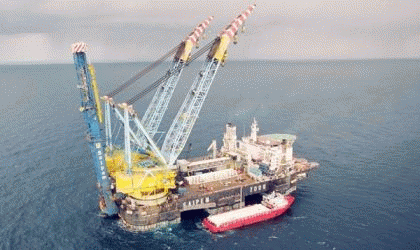The Eastern Europe unanimously placed its bet on the South Stream. Plain fact is that the new Europeans chose to protect their national interests in spite of all temptations and threats from Brussels and Washington. Now it is not an overstatement to say: the South Stream business blueprint is complete and it is entering construction stage. By the end of 2018 the pipeline is planned to reach a transport capacity of 63 billion cubic meters per year - enough gigajoules to supply energy needs of 38 million households. What has encouraged the pro-South Stream choice of Eastern European political elites presuming their frosty relations with Russia? Why did they not resort to broadly advertised alternatives?
by Gazprom
The not-so-obvious answers to these geopolitical riddles are conditioned by cold math and economic forecasting. Independent economic feasibility studies show that expensive and bulky South Stream is the only realistic way to guarantee safe and reliable natural gas supplies to Europe. It will play a pivotal role in the regional energy security up to 2030-es. Other sources like nuclear power or renewable sources are nothing more than perspective alternatives. Sovereign national leaders in Budapest and Belgrade understand very well: overoptimistic advertisements of wind energy on Euronews TV channel will not power heating networks in their countries. And the notorious Cyprus affair ruined the last remnants of their belief in -European solidarity -.
Let's have a look at energy statistics. The primary production of renewable energy within the EU in 2010 was 166.6 million tonnes of oil equivalent -- a 20.1 % share of total primary energy production from all sources. EU renewable energy targets 2020 are very ambitious in times of financial turmoil. But even if the European Commission completes this costly energy program, the total share of alternatives will reach only 30%. It means that today the end users in the Eastern Europe are in urgent need of stable fossil fuel source. Brussels understands it very well, but puts a brave face on a sorry business. Now the EU officials are presenting paper-and-pencil pipelines trying to lure Azerbaijanian businessmen into their controversial Nabucco West project. Although even the main US lobbyist for the Nabucco West, former US Ambassador to Baku Matthew Bryza admits: -the chances [of the South Stream] are excellent. When the leader of Russia puts his mind to a pipeline it happens -.
Bulgaria will develop both the South Stream and the atomic engineering. Sofiais planning to construct a new 1,000-megawatt (MW) reactor at the existing Kozloduy NPP with the help of the Russian company -Atomstroyexport -. In 2012 Bulgarian officials broke the deadlock in negotiations with Gazprom and signed a protocol of the final investment decision on the South Stream. The construction of gas receiving facilities will start in Bulgaria in 2013. -A 538-kilometer section of the gas pipeline will provide Bulgarian consumers with continuous and uninterrupted natural gas supplies over a long term -, said Alexey Miller, the CEO of Gazprom. As early as 2009, Sasho Dontchev, Executive Director of Bulgaria's Overgas explained why his country stands with Russia: -We mostly have to discuss real opportunities. Nabucco would be very fine as it assures an alternative supplier and an alternative route, but the project hasn't been sustained by the sufficient amount of gas. Therefore, the South Stream seems more preferable to me now. -
Serbia was the first South Stream member country to adopt the pipeline's final investment decision. South Stream's first facility -- the Banatski Dvor underground gas storage - shaved gas consumption peaks in Serbia during the 2011/2012 cold winter season. Early 2013 Sebian government promised to grant the South Stream national significance status. Managing Director of state-owned Srbijagas Dusan Bajatovic confirmed that the construction of South Stream in Serbia will begin by the end of 2013. Now project implementation is going according to plan despite all sorts of speculation in a number of Serbian media outlets. In March, 2013 Mr. Bajatovic explained that some international -business groups - attempted to lobby against the South Stream, but failed. If we take into account US intrigues in Bulgaria against the Kozloduy NPP, this assumption doesn't seem improbable.
Croatia gave a final nod to the South Stream in January 2013. Environmental impact assessment procedures required by national law are currently at their final stage. Gazprom and Croatia's Plinacro inked an Action Plan to implement the South Stream project between 2013 and 2016. The document envisages that a joint project company for building a gas branch to Croatia will be set up at the beginning of the second half of 2013.
Hungary performed a feasibility study for the Hungarian section of the South Stream in 2011. It resulted in the approval of the final investment decision on building of a 229 kilometers long pipeline section. Moreover, Budapest granted the South Stream the status of a national significance project. Csaba Baji, CEO of the MVM Group, the largest Hungarian power company, favors the deal: -With the Hungarian Government's support, we are committed to increasing energy security and diversifying the routes of natural gas supply to the European Union. The South Stream project is an important part of our long-term strategy -.
Slovenia teamed up with Gazprom for the South Stream on November 13, 2012. Slovenian stakeholders including energy company Plinovodi signed the final investment decision on construction of the gas pipeline section in this country. Priority is given to environmentally friendly construction schemes and economic efficiency. The Russian investors entrusted the majority of technical and operational work to the state-owned Slovenian natural gas company Geoplin for the purpose of carrying out the joint enterprise.
If we consider strategic agreements, economic feasibility studies and environmental assessments completed by the sovereign Eastern European energy companies, we can predict, that the South Stream project will be completed by 2018-2020, but with estimated cost overrun (approximately $39 billion -- see fact sheet below). The rival consortium Nabucco West targets the same market as the South Stream. Although today these projects do not complete on equal terms. The South Stream boasts fixed construction schedule and a plethora of bilateral agreements with transit states, while the Nabucco West still undergoes negotiation process. Given the geopolitical importance of energy supplies to Europe, it is very probable that in the long term Nabucco West will eventually be completed, although the South Stream being a large-scale project may by that time capture lion's share of the market.
________________________
The South Stream Fact Sheet
Gas pipeline will be 1455 km long in Southern and Central Europe;
Eight compression stations are to be set up in the main transit countries;
The South Stream planned transport capacity may reach 63 billion cubic meters;
The overall cost of the project is approximately $39 billion.






